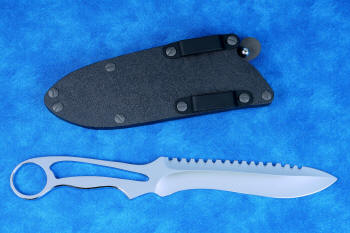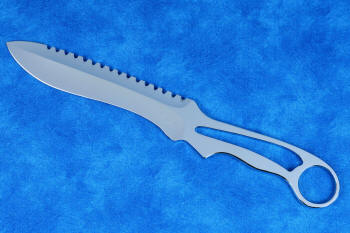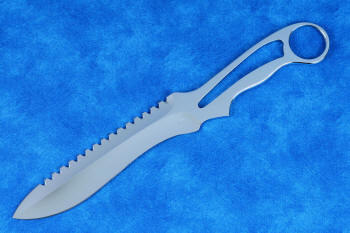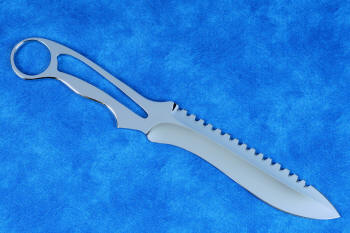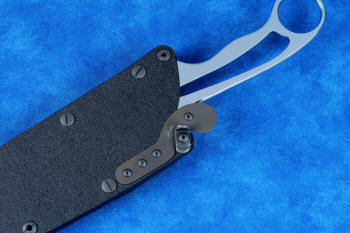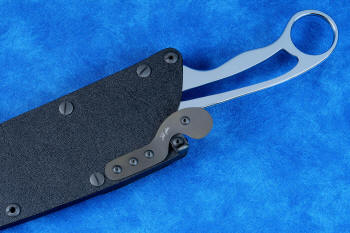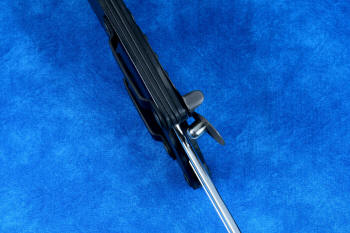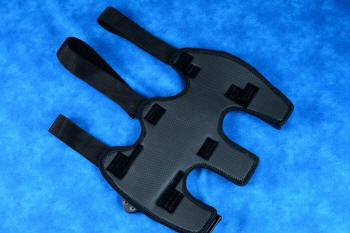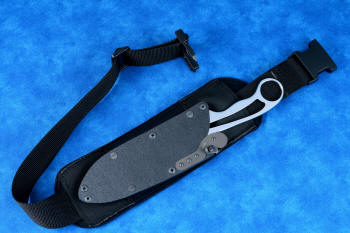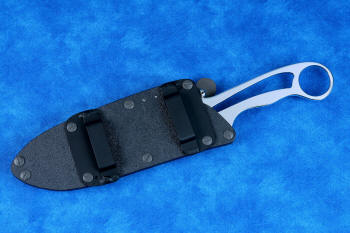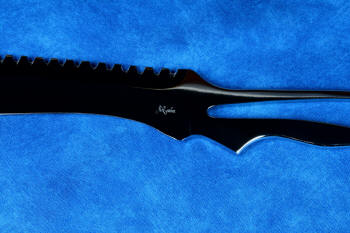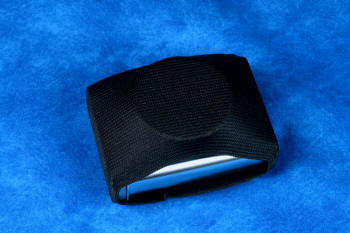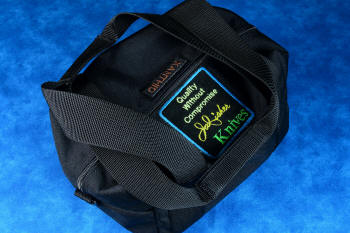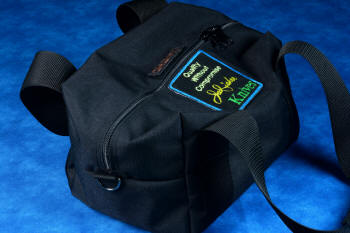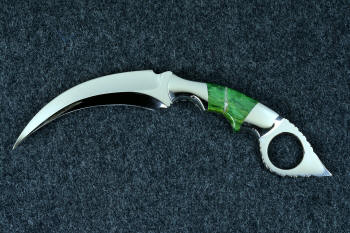Xanthid (Reef) Custom Knife

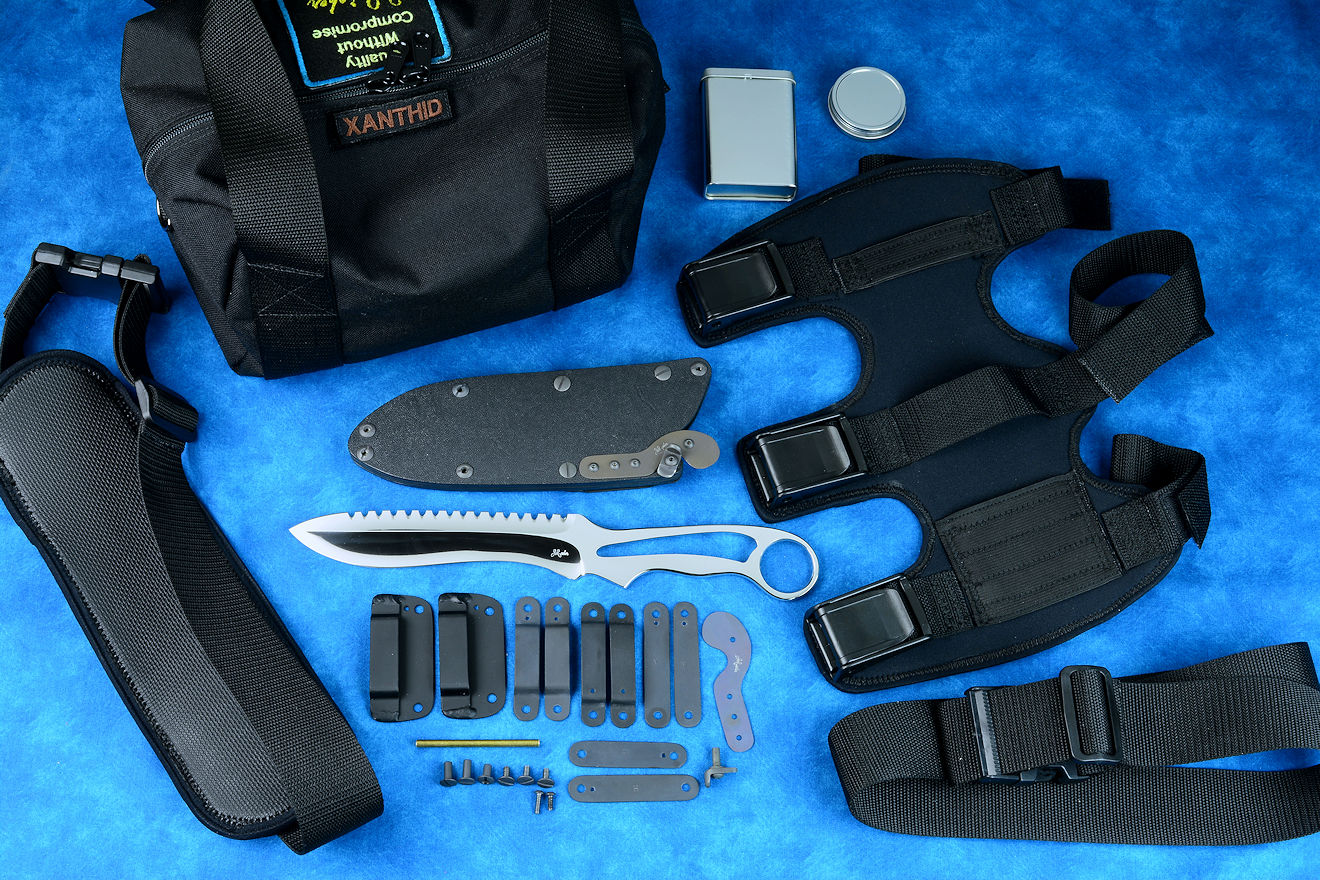
"Xanthid" (Reef) Custom Professional Tactical Dive Knife
- Size: Length overall: 13.0" (33.0 cm), Blade Length: 7.0" (17.8 cm), Thickness: 0.205" (5.2 mm)
- Weight: Knife: 7.1 oz. (201 grams) Sheath: 11.1 oz. (315 grams)
- Blade: 440C high chromium martensitic stainless steel blade, T3 deep cryogenically treated with triple tempering to 58 HRC, mirror polished
- Sheath: Locking-tab-wedge hybrid tension in kydex, anodized 5052H32 aluminum, blackened and passivated 304 stainless steel, anodized 6AL4V titanium
- DCAM: Dive Calf Accessory Mount in SCUBA rated 6.7 mm neoprene foam rubber, nylon, polyester, polypropylene, acetyl
- DBAM: Dive Belt Accessory Mount in SCUBA rated 6.7 mm neoprene foam rubber, nylon, polyester, polypropylene, acetyl, with two belts
- Hardware, Fasteners: 304 stainless steel, blackened and passivated, 6AL4V anodized titanium
- Duffle: 1000 Denier Cordura Ballistic Nylon, polypropylene, polyester, nylon, blued steel, embroidered tags
- Knife: Made for a great client to his
specifications, this is my Xanthid tactical dive knife, the same
knife I've made for counterterrorism response professionals.
"Xanthid" is the family of crustaceans composing the most toxic and
deadly crabs in the sea. Atypically, this pattern is also known
in my pattern inventory as "Reef." This is a true professional grade
custom tactical and working dive knife, made completely for wear in
the salty marine environments encountered in the ocean. It is an
ultimate dive knife, built for long lasting durability, extremely
secure wear, light weight, and
serious use. The knife is upgraded somewhat from previous models,
with some important distinctions.
- The steel I chose for this knife is 440C high chromium martensitic
stainless steel, my most requested steel for a reason. When
properly treated, it's a dependable, reliable workhorse of
extremely high corrosion resistance, good toughness and high
wear resistance. The extremely high chromium of 440C along
with the high carbon and moderate molybdenum results in
profuse chromium carbides, increasing corrosion resistance
as well as wear resistance. To bring this steel to its
zenith, I used my proprietary T3 deep cryogenic process in
heat treating this blade; it's a highly detailed, extremely
sophisticated process that takes 33 individual steps and
takes over a week long. The result of this is an incredibly
wear-resistant blade that has extremely high carbide
development, fine grain, and extremely high corrosion
resistance. Asperity is reduced; the microstructure
development is superior to any other typical handmade knife,
and far above any factory or manufactured knife. This is,
simply put, 440C at its very finest advanced condition.
- The knife feels feels much more
substantial than it looks in a photograph. I've milled and
polished the entire handle so that corrosion can't start and
the knife is easily cleaned with just a rinse in clear water. The
large handle has plenty of curvature to grip and the rear
finger ring accommodates the hand in either forward or
reversed grip style. The ring and the central handle
millwork can both accommodate a lanyard, and when the
lanyard is hitched in the central
position, the lanyard won't get in the way of the finger ring
for use. The large front quillon stops the hand from moving
forward on the blade, and the thumb rise protects the thumb
from the serrations. The serrations are my incredibly sharp
hammerhead serrations; they will rip through just about
anything short of metals. I've put plenty of length, about
5.5" (14 cm) of them on the blade, and the central thick
spine of the double-edged knife supports them well. The
first 1.5" (3.8 cm) of the blade tip on the serration
side is razor keen for easy piercing. The main
cutting edge is keen beyond belief. I can make it this way
because of several properties. First, the sophisticated
treatment of this steel produces an superior microstructure,
capable of extremely small grain size, leading to great
strength. I've tempered the steel to 58 HRC, so the blade
has substantial toughness and resistance to fracture. The
hollow ground edge is very thin, and in the recurve, it's
stunningly sharp. This is because the geometry of a hollow
grind and a recurve both together creates the very thinnest,
and then sharpest cutting edge possible. The thickness
behind the cutting edge at the recurve is only 0.015" thick,
that's less than the thickness of four sheets of notebook
paper! Though the steel behind the edge is twice as thick at
the belly of the blade, I made the recurve this way so the
knife will always have the capability to slice cordage,
line, and rope at the recurve, while the point and belly are
expected to do heavier work, like piercing and ripping. The heaviest work can be done
by flipping the knife over and using the aggressive
serrations. The balance point of the knife is exactly at the
ricasso, and it feels quite large in the hand.
- Sheath: The sheath is an advanced evolution of my hybrid tension-locking sheath,
a positively locking, wedge-opening model.
- Materials: It's built on a frame
of 5052 H32 corrosion-resistant high strength aluminum alloy welts.
The individual welts are then anodized for a full mil of thickness,
twice the thickness of typical anodizing. The anodizing creates a
built-up near-ceramic hard surface on the aluminum, and it's
entirely corrosion-resistant and non-conductive. It's permanently
dyed (in black) and sealed with a solution that inhibits ultraviolet
degradation of the dye and anodized surface. In fact, all of the
aluminum components in this assembly are the same alloy
and are treated this way; this is
the most advanced condition for marine use. The sheath front and
back are double-thickness kydex, twice the thickness of typical
knife sheaths, and the sheath is bonded with waterproof marine-grade
cement and secured with darkened and passivated 304 stainless steel
Chicago screws.
- Layout: As with all of my sheaths, they are built on a 2.5"
center hole pattern, so the components can be moved around an
mounted in various positions on the sheath. As with all
of my tactical sheaths, this one is completely reversible
for as many wear options as possible. Most of my accessories can be used on this
sheath, including any new ones I develop.
- Horizontal Belt Loop Plates for horizontal belt or webbing wear,
welded for ultimate strength and light weight,
reversible, and in black anodized aluminum.
- Flat mounting straps for rigid clamping to
webbing, belts, or gear in vertical or horizontal
orientation in black anodized aluminum.
- Low profile belt loops
(footman's loops): for tactical webbing belts with
maximum .190" thickness and 1.5" width in black
anodized aluminum
- High profile belt loops
(footman's loops): for tactical webbing belts with
maximum .250" thickness and 1.5" width in
black anodized aluminum
- High profile wide belt loops
(footman's loops): for tactical webbing
belts with maximum ..250" thickness and 1.75" width
in black anodized aluminum
- Lanyard: SCUBA rated, not shown in photos
- All necessary stainless steel hardware, fittings, fasteners and tools for mounting, moving, and adjusting
- Locking-Tab-Wedge (LTW): An advanced feature of
this knife sheath is designed for dive use: the security and retention
mechanism. I've used my standard hybrid tension lock, so the knife
can be retained with the pressure of an anodized 6AL4V titanium
dog-leg spring, and I've included a pair of those so the user can
choose which strength to apply. Normally, in an emergency, the ball
and spring can be deflected with a hard tug, and I wanted to leave
that choice to my client if he wished for a standard setup. However,
in the ocean, it's more important to have a more secure, even
locking retention method, and to not have to struggle
or use two hands to re-sheath
the knife. This sheath includes my locking-wedge-tab. These three
words are the best to describe the LTW mechanism. When sheathed, the
small tab can be rotated over the top of the titanium spring, preventing it
from moving away from the knife axis, effectively locking the knife
in the sheath. When the user needs the knife, he simply pulls the
tab toward his hand with his thumb, and the locking flat of the tab rotates
off the spring, and the wedge lifts the titanium spring and ball
away from the knife, clearing the blade, the serrations, and leaving
the entire mouth of the sheath open. Then, the knife is unsheathed.
It takes much more effort to describe it than to use it; the motion
is natural with the thumb. You wrap your hand around the handle,
pull-flip the locking-tab-wedge, and extract the knife. Reinsertion
is just as simple; you slip the knife in the sheath (as the ball and
is completely out of the way) and then use the thumb to
push-swivel the
tab forward, closing the ball on the thumb rise, and locking the
knife in the sheath. Because I've built these sheaths to be
completely reversible, I've included two locking-tab-wedges, one for
each side. If my client wants to forego the locking-tab-wedge
entirely, he simply replaces the post mounted to the rotating tab
with a standard Chicago screw post, and he then has the typical
hybrid tension-lock. Improving this design is representative to
my commitment to excellence in service to the people who
purchase and depend on these knives, and it's an honor to design
these for the hardest of environments and use.
- Knife/Sheath wear options: A knife is worn, not
carried, so this is critical for a tactical dive knife. In addition
to typical wear positions (on a belt, on PALS webbing, body armor,
or gear and equipment bags, packs, and frames), this knife has some
very specialized wear gear:
- DCAM (Dive Calf Accessory Mount): This
is my calf-mounted assembly, one that is worn
comfortably against the bare skin underwater, can stay put while
active, yet keep the razor sharp edge and deadly point of the
Xanthid immediately accessible. It is constructed
entirely of waterproof dive-rated materials, and is secure as it
can possibly be, wrapping around the calf with three strap
mounts of wide, strong webbing. The base is soft, thick 6.7 mm
neoprene foam with textured body-contact rubber on the inside,
and tightly woven nylon on the outside. This is very heavy
wetsuit material, and the mounts for the straps and webbing are
backed with soft Velcro® loop stitch pads to back up the
stitches. The webbing is secured with bonded polyester
waterproof thread, size V-138 for extreme durability. The
outside of the wrap is sealed and bonded with nylon wetsuit
material, stitched with flexible nylon. The sheath tail pocket and
anti-flop shock cord are double thickness elastic nylon; the
tail pocket is three inches deep, and the anti-flop shock strap
is .75" wide. The sheath body clamps rigidly under the center web, and is trapped
between the webbing and the wrap, so is extremely secure. The
buckles are all 1.5" cam lock Acetyl plastic and are infinitely
adjustable yet can be quickly released in an emergency. This is
a very comfortable rig, and will be a favorite wear accessory in
the future. Photos
below are of "Synan," but the rig is the same. My model
is my Grandson, USMC Malachi Beauchamp.
- DBAM (Dive Belt Accessory Mount): Also
included is accessory that allows the knife to be worn in
the middle of the back or the front, with horizontal
orientation. This is the DBAM, Dive Belt Accessory Mount,
which I made of 2" wide polypropylene webbing with Acetyl
buckle, the same material as the Sternum Harness for my
counterterrorism knife sheaths. The belt accommodates the
width of the span between the flat clamp straps when worn
horizontally, so the sheath clamps rigidly to the belt. The
custom pad is made of the same 6.7 mm wetsuit foam neoprene
as the DCAM, edge stitched and sealed, and held in place
with two 3" wide double thickness elastic nylon straps. The
pad stays in place, protecting the body from the sheath, and
it's a comfortable, secure rig in or out of the water. I've
also included an extra-length belt for a variety of wear
sizes. Photos below are of "Synan," but the rig is the same. The model is my Grandson, USMC Malachi Beauchamp.
- Standard Wear Options: the kit includes
all of my basic standard wear mounts; belt loops, flat
clamping straps, horizontal belt loop plates, and all
necessary hardware, screws, fittings and tools.
- Containers, Instructions, Archival: included are tin plated
steel containers for the fasteners and hardware, and the
instructions for the rig including a checklist for the
kit. Included is an engraved co-extruded acrylic archival plate.
- Duffle: One thing I found out over the years
was a need to store these components that was as tough and durable
as what they contained. This is why I make the duffles, in my
studio, by hand. I make them in 1000 Denier Cordura ballistic nylon,
which is coated on the inside with polyurethane for moisture
resistance. This is some very tough stuff, and I triple-stitch the
seams, all in heavy polyester thread. I've included steel D-rings at
the zipper stops on the ends for several reasons: to mount accessory
straps or carry options, to clip accessories, and to oppose the
zipper when pulling open. Otherwise, you have to pinch the material
to open the zippers with one hand and pull the zipper pull with the
other. I've used double zipper pulls, for quick and easy access, and
stitched on 2" wide webbing straps in polypropylene, permanently
mounted in position on the duffle body, and they are reinforced and heavily
stitched on the inside of the duffle, as well as the handle areas.
The design of the duffle is a box-end, so that the duffle stores
neatly. It has my (rather handsome) patch signifying "Quality
Without Compromise" and my maker's mark. Opposing that is a hook and
loop stitched tag mount, with a removable embroidered identifier of
the knife pattern. This is important when clients have more than one
knife. These duffles are so great, I have clients buying them
alone without a knife, for their friends and other stowed gear!
- This is a great dive knife kit, ready to take to the water, and
it was an honor to make it!
Thanks, P. K.!
They arrived today. I expect perfection and you delivered as always.
The kits were a surprise to me. I know this sounds stupid to you, but, I am so use to
a masterpiece and a sheath to be put on display. The embellishments, on the weapons, cause
one to look at them as art pieces and not weapons of war. The kits bring home the seriousness
of your works and the need for full kits. In the future I will get full kits.
I would guess the majority of patrons do not truly understand what you do. The trolls and detractors
miss the mark completely. Your creations mean the difference between life and death.
Yours Truly:
P.
Please click on thumbnail knife photos
